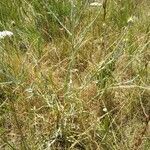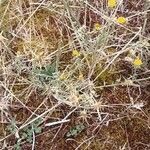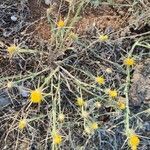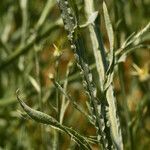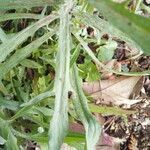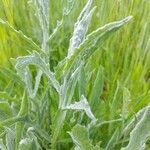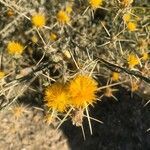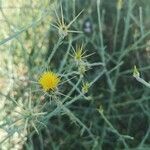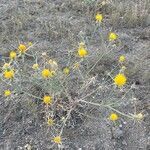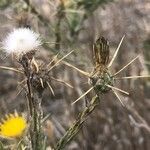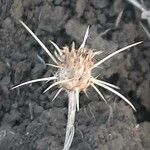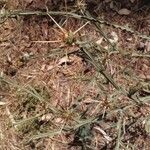Biennial. Stems suberect to erect, weakly ribbed, branched, (10)-25-80 cm tall, with lanate to floccose tomentum. Lvs decurrent to form wings on stems, lanate; lower lvs pinnatifid, 6-12 × 1-3 cm, with triangular, oblong or linear, sinuate or lobed segments; upper lvs linear-lanceolate to narrowly triangular, entire or sinuate or toothed. Capitula not clustered. Involucre ovoid, (5)-7-12 mm diam.; outer and middle bracts ovate, not veined, with cobwebby hairs; appendages spreading to reflexed, not covering bracts, spinous, not narrowed at junction with bract, not decurrent on bract; terminal spine 15-25 mm long, shorter on outermost bracts, yellowish; lateral spines 2-(3) on each side, (1)-2-4 mm long, all at base of terminal spine. Florets yellow, all tubular. Corolla eglandular. Achenes 2.5-3 mm long, glabrous; pappus 3-4 mm long.
Annual or biennial to 0.8 m high. Stems with dense adpressed arachnoid persistent hairs; wings present. Cauline leaves narrowly lanceolate to linear, entire, grey above and below, with adpressed arachnoid hairs; sessile glands present. Capitula solitary, pedunculate; involucre ovoid to globose, 8–11 mm diam. at anthesis; median involucral bracts elliptic to ovate, 4–7.5 mm long, 3–4 mm wide, with arachnoid hairs; appendages comprising a straight, patent, pungent, terminal spine 12–26 mm long with 2 pairs of lateral spinules near base of spine. Florets yellow; inner (fertile) florets with tube 10–14 mm long, not glandular, and lobes 3–4.5 mm long; sterile florets shorter than fertile florets. Anthers 5.5–7 mm long. Achenes cylindrical, 2.5–3 mm long, glabrous, brown. Longest pappus bristles 3–4 mm long, white.
Annual or biennial, 2–8 dm, thinly but persistently tomentose, the stem evidently winged by the decurrent lf-bases; basal lvs lyrate or pinnatifid, to 20 × 5 cm, the middle and upper smaller, becoming linear and entire; invol 10–15 mm, broad-based; middle and outer bracts spine-tipped, the larger central spines 11–22 mm; inner bracts with a small hyaline appendage; fls yellow, the marginal ones not enlarged; pappus of the marginal fls wanting, that of the others 3–5 mm; 2n=16. A weed in fields and waste places, native to the Mediterranean region, occasionally found in our range.
Annual herb, up to ± 0.9 m high; erect, freely branched; stems thin, wiry, winged, woolly. Leaves: basal lyrate; cauline leaves narrow, linear, entire, woolly; bases decurrent. Involucre globose; outer bracts ovate, subcoriaceous, arachnoid; inner bracts unarmed, apex tapering and usually dilated and chartaceous. Florets yellow. Flowering time Jan.? Pappus of slender white bristles. Cypselae stramineous with darker brown striations.
An annual plant. It grows 1 m tall. It is stiff and erect and has a downy white covering. The leaves at the base are much divided. The lobe at the end is the largest. The leaves on the stem do not have stalks. They are narrow and entire. They continue as wings down the stem. The bracts around the flower have spines. Some spines are smaller than others.
Annual or biennial herb, up to 1 m high. Leaves narrow, linear, entire, grey, woolly, bases decurrent. Heads discoid. Involucral bracts tipped by long spines, bearing 2-4 short lateral spines at base. Flowers yellow.
